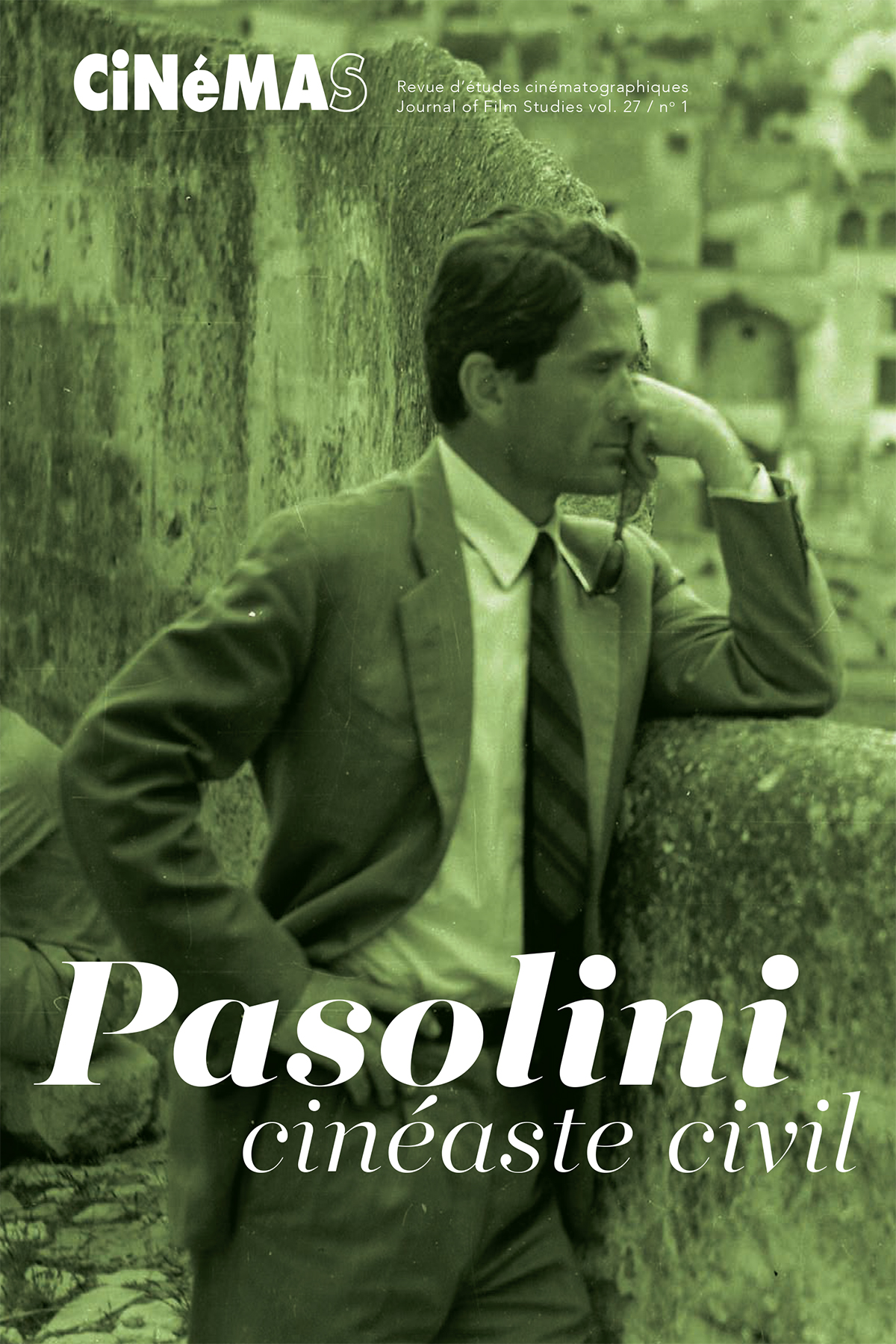Abstracts
Résumé
Pier Paolo Pasolini a vécu sa jeunesse sous le ventennio nero : vingt années de mises en scène grandiloquentes de la romanità, sur fond de décors de marbre qu’une archéologie très sélective manipule. L’étude de ses premiers textes permet de retracer la genèse d’une résistance à ce que l’historien Eric Hobsbawm a appelé « l’invention [fasciste] des traditions ». En analysant les trois écoles fondamentales dont se réclame Pasolini dans sa correspondance — Longhi, la réflexion sur la langue (hermétisme et dialecte) et Freud —, ainsi que les concepts (l’histoire, la tradition) qu’il dispute au fascisme dans ses premiers textes publiés, cet article met en évidence l’élaboration d’une pensée de l’invention artistique, entendue au sens étymologique et archéologique de la mise au jour de données invisibles, car exclues de l’idéologie officielle, reléguées « hors champ », interdites de représentation. L’article se termine par une analyse succincte de la traduction qu’a faite Pasolini de fragments de la poétesse grecque archaïque Sappho, l’un des premiers exemples d’une matrice grecque qui informera toute son oeuvre à venir.
Abstract
Pier Paolo Pasolini grew up under the ventennio nero: twenty years of grandiloquent stagings of romanità against a marble backdrop manipulated by a selective archaeology. The study of these earliest texts makes it possible to trace the genesis of Pasolini’s resistance to what the historian Eric Hobsbawm has called “the [fascist] invention of traditions.” By analyzing the three fundamental schools on which Pasolini, in his correspondence, claims to draw—Longhi, studies of language (hermeticism and dialect) and Freud—along with the concepts (history, tradition) he contests in his earliest texts with respect to fascism, this article shows the development of a way of thinking about artistic invention, understood in the etymological and archaeological sense of bringing to light facts which are invisible because they are excluded from the official ideology, relegated to the sidelines and forbidden to depict. The article concludes with a succinct analysis of Pasolini’s translation of fragments of the ancient Greek poet Sappho, one of the first examples of a Greek model that would inform his entire future oeuvre.
Appendices
Appendices
Bibliographie
- Canfora 1989 : Luciano Canfora, Le vie del classicismo, Bari, Laterza, 1989.
- David 1966 : Michel David, La psicoanalisi nella cultura italiana, Turin, Boringhieri, 1966.
- Eco 2003 : Umberto Eco, Dire presque la même chose. Expériences de traduction [2003], traduit de l’italien par Myriem Bouzaher, Paris, Grasset, 2007.
- Foro 2006 : Philippe Foro, L’Italie fasciste, Paris, Armand Colin, 2006.
- Hobsbawm 1983 : Eric Hobsbawm, « Inventer des traditions » [1983], Enquête, no 2, 1995, p. 171-189.
- Joubert-Laurencin 2010 : Hervé Joubert-Laurencin, « La lumière du temps. Trois notes sur quatre textes de Pasolini », Trafic, no 73, 2010, p. 125-126.
- Levergeois 2005 : Bertrand Levergeois, Pasolini. L’alphabet du refus, Paris, Éditions du félin, 2005.
- Malvano Bechelloni 2003 : Laura Malvano Bechelloni, « Le mythe de la romanité et la politique de l’image dans l’Italie fasciste », Vingtième Siècle, vol. 2, no 78, 2003, p. 111-120.
- Moravia 1990 : Alberto Moravia, Vita di Moravia [1990], entretiens avec Alain Elkann, Paris, Christian Bourgois, 1991.
- Pasolini 1942 : Pier Paolo Pasolini, « Discours sur la douleur civile » [1942], traduit par Hervé Joubert-Laurencin, Trafic, no 73, 2010, p. 126-128.
- Pasolini 1955 : Pier Paolo Pasolini (éd.), Canzoniere italiano : antologia della poesia popolare, Parme, Guanda, 1955.
- Pasolini 1976 : Pier Paolo Pasolini, L’expérience hérétique. Langue et cinéma, traduit de l’italien par Anna Rocchi Pullberg, Paris, Payot, 1976.
- Pasolini 1977 : Pier Paolo Pasolini, Pylade [1977], Arles, Actes Sud, 1990.
- Pasolini 1986 : Pier Paolo Pasolini, Lettere1940-1955, Turin, Einaudi, 1986.
- Pasolini 1991 : Pier Paolo Pasolini, Correspondance générale (1940-1975), lettres choisies et traduites par René de Ceccatty, Paris, Gallimard, 1991.
- Pasolini 1993 : Pier Paolo Pasolini (éd.), Antologia della lirica pascoliana, Turin, Einaudi, 1993.
- Pasolini 1994 : Pier Paolo Pasolini, Qui je suis [1994], traduit par Jean-Pierre Milelli, Paris, Arléa, 1999.
- Pasolini 1997 : Pier Paolo Pasolini, Écrits sur la peinture, textes choisis et traduits par Hervé Joubert-Laurencin, Paris, Carré, 1997.
- Pasolini 1998 : Pier Paolo Pasolini, Romanzi e racconti. 1946-1961, Milan, Mondadori, 1998.
- Pasolini 1999a : Pier Paolo Pasolini, Saggi sulla letteratura e sull’arte, Milan, Mondadori, 1999.
- Pasolini 1999b : Pier Paolo Pasolini, Saggi sulla politica e sulla società, Milan, Mondadori, 1999.
- Pasolini 2003 : Pier Paolo Pasolini, Tutte le poesie, vol. 1, Milan, Mondadori, 2003.
- Pasolini 2010 : Pier Paolo Pasolini, « La lumière du Caravage », traduit par Hervé Joubert-Laurencin, Trafic, no 73, 2010, p. 129-131.
- Pasolini 2015 : Pier Paolo Pasolini, « Le jeune du printemps », traduit par Anne-Violaine Houcke et Daniele Rivoletti, Le Magazine littéraire, no 551, 2015, p. 86-88.
- Settis 2004 : Salvatore Settis, Le futur du classique [2004], traduit par Jean-Luc Defromont, Paris, Liana Levi, 2005.
- Siciliano 1978 : Enzo Siciliano, Pasolini, une vie [1978], traduit de l’italien par Jacques Joly et Emmanuelle Genevois, Paris, La Différence, 1983.

